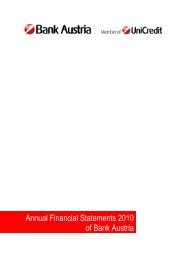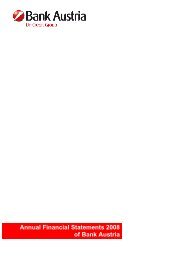Annual Financial Statements 2011 of Bank Austria
Annual Financial Statements 2011 of Bank Austria
Annual Financial Statements 2011 of Bank Austria
You also want an ePaper? Increase the reach of your titles
YUMPU automatically turns print PDFs into web optimized ePapers that Google loves.
Consolidated <strong>Financial</strong> <strong>Statements</strong> in accordance with IFRSs<br />
E – Risk report (CoNTINuED)<br />
E.4 – Counterparty risk<br />
UniCredit <strong>Bank</strong> <strong>Austria</strong> AG has made further efforts to refine the risk management model for derivatives, securities lending and repurchase agreements.<br />
For the purposes <strong>of</strong> portfolio management and risk limitation in the derivatives and security financing business with banks and customers,<br />
the bank uses an internal counterparty risk model (IMM) based on a Monte Carlo path simulation to estimate the potential future exposure at portfolio<br />
level for each counterparty.<br />
The counterparty risk model (NORISK CR), which was approved by the <strong>Austria</strong>n supervisory authority in 2009, was extended in <strong>2011</strong> to include<br />
further CEE countries for risk management aspects; special mention should be made <strong>of</strong> the subsidiaries in Croatia and Russia because <strong>of</strong> their<br />
size. In this context the focus is on risk management and not yet on regulatory approval. The bank took account <strong>of</strong> the growing importance <strong>of</strong><br />
counterparty risk by creating a separate unit for this purpose within Market Risk and Risk Integration at the beginning <strong>of</strong> 2010.<br />
The calculations are based on market volatility, correlations between specific risk factors, future cash flows and stress considerations. Netting<br />
agreements and collateral agreements are also taken into account for simulation purposes.<br />
The simulation calculations are performed for all major types <strong>of</strong> transactions, e.g. forward foreign exchange transactions, currency options, interest<br />
rate instruments, equity/bond-related instruments, credit derivatives and commodity derivatives. Other transactions are taken into account with an<br />
add-on depending on factors such as maturity. The bank applies a confidence interval <strong>of</strong> 97.5%.<br />
At the end <strong>of</strong> <strong>2011</strong>, derivative transactions, repurchase agreements and securities lending transactions resulted in the following exposures:<br />
Exposures (€ bn)<br />
<strong>Austria</strong> 3.05<br />
CEE 3.56<br />
tOtal 6.61<br />
In addition to further refinement <strong>of</strong> the model, which is currently in conformity with Basel 2 standards, we are now concentrating on preparations<br />
for adjusting the existing model to the new Basel 3 rules concerning counterparty credit risk. A project was initiated in Market Risk and Risk Integration<br />
for this purpose. Separate reporting on counterparty risk was introduced with a view to informing UniCredit <strong>Bank</strong> <strong>Austria</strong> AG’s Market Risk<br />
Committee and Derivative Committee (DECO) <strong>of</strong> current exposure trends and providing additional information relevant to risk management. Moreover,<br />
backtesting is performed at regular intervals, at the level <strong>of</strong> individual counterparties and at overall bank level, in order to check the quality <strong>of</strong><br />
the model on an ongoing basis.<br />
Line utilisation for derivatives and security financing business <strong>of</strong> customers is available online in WSS (“Wallstreet”), the central treasury system,<br />
on a largely group-wide basis. In addition to determining the potential future exposure, the path simulation also enables the bank to calculate the<br />
average exposure and the modified average exposure pursuant to Basel 2 (exposure at default), as well as the effective maturity <strong>of</strong> the exposure to<br />
each counterparty. This makes it possible to integrate counterparty risk in an internal model compliant with Basel 2.<br />
UniCredit <strong>Bank</strong> <strong>Austria</strong> AG additionally limits the credit risk arising from its derivatives business, repurchase agreements and securities lending<br />
business through strict use <strong>of</strong> master agreements, the definition and ongoing monitoring <strong>of</strong> documentation standards by legal experts, and through<br />
collateral agreements and break clauses. Management takes proper account <strong>of</strong> default risk, especially because the relevance <strong>of</strong> this risk category<br />
has increased and on the basis <strong>of</strong> experience gained in the international financial market crisis, despite the good average credit rating <strong>of</strong> our business<br />
partners.<br />
<strong>Bank</strong> <strong>Austria</strong> · <strong>Annual</strong> <strong>Financial</strong> <strong>Statements</strong> <strong>2011</strong><br />
145
















